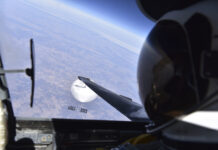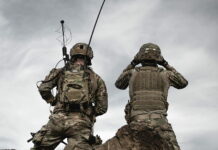Leading military powers are looking to new technologies and innovative designs to enhance the future survivability and operational effectiveness of their air forces.
As offensive and defensive technologies develop, armed forces that do not keep pace become vulnerable. Particular threats to aircraft are posed by increasingly long-range and discriminatory sensors coupled with long-range air defence weapons, stealth-enabled interceptor aircraft, and the looming spectre of unmanned interceptors which will forge even denser anti-access/area denial (A2/AD) networks. More capable enemy electronic warfare (EW) systems threaten to interfere with navigation and communication systems, including weapon guidance systems, at a time when military operations are becoming even more dependent on networking. The increasing focus on a potential conflict with Russia or China demands not only enhanced penetration and survival aids, but also significantly improved range for combat aircraft, air mobility aircraft (transports and tankers) and specialised enablers such as command and control units. Even future training aircraft will need to reflect the new threat environment as well as the capability profiles of next generation operational technology.
Sixth-generation (and beyond) tactical aircraft
The United States, several European nations and Japan are all actively pursuing sixth-generation combat aircraft systems which they hope to introduce, depending on the project, between approximately 2030 and 2040. The programmes in question are designated the Next Generation Air Dominance (NGAD) system of systems (US Air Force (USAF)); the F/A-XX NGAD (US Navy), which is distinct from the USAF NGAD; the Future Combat Air System (FCAS, being jointly developed by France and Germany, with Spanish participation); and the Global Combat Air Power (GCAP) system (Italy, Japan and the UK).
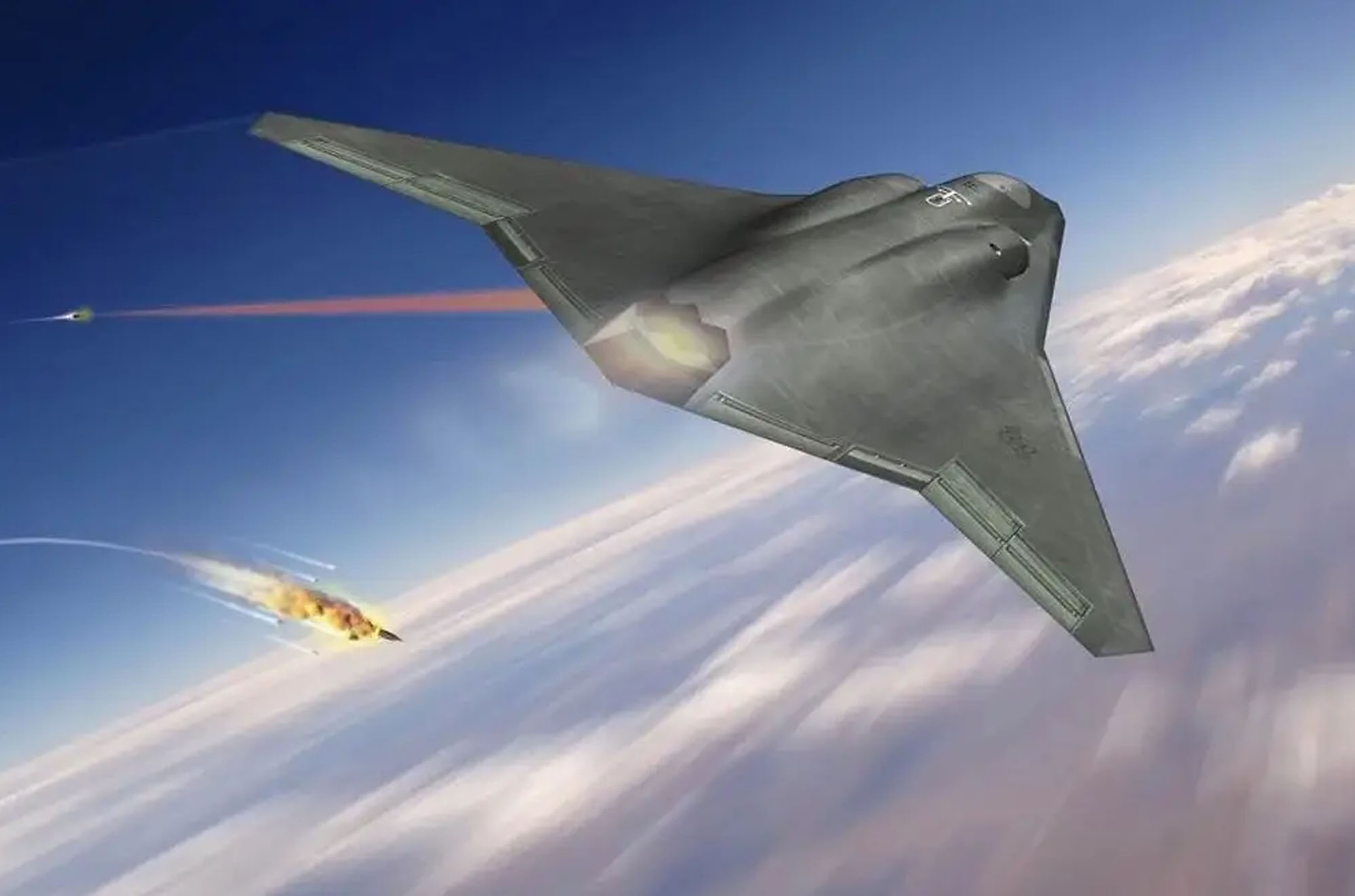
Credit: Northrop Grumman
As conceived, all of these sixth-generation tactical programmes envision a ‘system of systems’ or ‘family of systems’ approach, centred around a manned fighter aircraft augmented by unmanned tactical aircraft. In US parlance, these unmanned elements have been referred to as ‘loyal wingmen’ and more recently (and formally) as collaborative combat aircraft (CCA), while Airbus designates the FCAS equivalent as ‘remote carriers’ (RC). These unmanned aerial vehicles (UAVs) are expected to be controlled by the manned aircraft in a practice referred to as ‘manned-unmanned teaming’ (MUM-T) and perform numerous support functions ranging from advance reconnaissance to EW, but also kinetic warfare against enemy air-defence systems or even enemy combat aircraft. Overall, their role is to improve the manned aircraft’s survivability by identifying and neutralising threats along the flight path, and to enhance offensive capabilities by identifying targets for the manned aircraft’s long-range ordnance.
Details of these programmes remain, for the most part, classified. All sixth-generation tactical systems are expected to achieve a high level of connectivity, enabling not only the MUM-T with the CCA, but also establishment of a highly sophisticated situational awareness network encompassing aircraft, ships, ground stations and satellites. This network is expected to enable cooperative engagement capabilities and exchange of threat or target data between all relevant platforms and control stations, maximising speed and effectiveness of offensive operations while reducing the need for individual aircraft to expose themselves to enemy fire. The manned aircraft will have advanced stealth characteristics, achieved through a combination of optimised design, radar absorbent materials, and minimised thermal, acoustic and electronic emissions. They will feature open architecture design, enabling frequent and uncomplicated upgrading with new components and software. Long-range active and passive sensors, advanced weaponry and electronic suites will permit deployment not only in strike roles but also for reconnaissance, surveillance and target acquisition (RSTA) missions as well as offensive and defensive EW missions. A high degree of artificial intelligence (AI) and machine learning (ML) is expected to support the human pilot, enhancing decision-making during fast-paced operations.
While sixth-generation combat aircraft systems are currently in the early stages of development, there is already discussion about the ‘generation after next’ fighter. At a 14 May 2024 media roundtable, BAE Systems executives outlined their firm’s Combat Air Continuum concept, projecting future airpower developments over the next quarter-century. BAE’s Combat Air Strategy Director Mike Baulkwill brought up the topic of seventh-generation tactical airpower, although he stressed that it was too early to predict “where 7G aircraft development is heading.” Both Baulkwill and the firm’s military advisor for FCAS, Jonny Moreton, agree that tactical air fleets of the next ten to 15 years will be marked by a mix of fourth-, fifth- and sixth-generation aircraft increasingly supported by CCA. Beyond that – somewhere between the mid-2040s and mid-2050s – BAE predicts a transition to “full 6G capabilities, augmented by autonomous combat aircraft taking diverse roles [and] potentially 7G fighter aircraft programmes being developed [with] potential for wider collaboration and consolidation.” That being said, both men cautioned that terminology such as seventh-generation may no longer be applicable or relevant by that time, noting “There will be a baseline architecture which could be developed quickly and in an agile manner,” but the aircraft will likely be “forever changing” through very frequent software updates and spiral developments which will preserve the operational system’s technological edge.
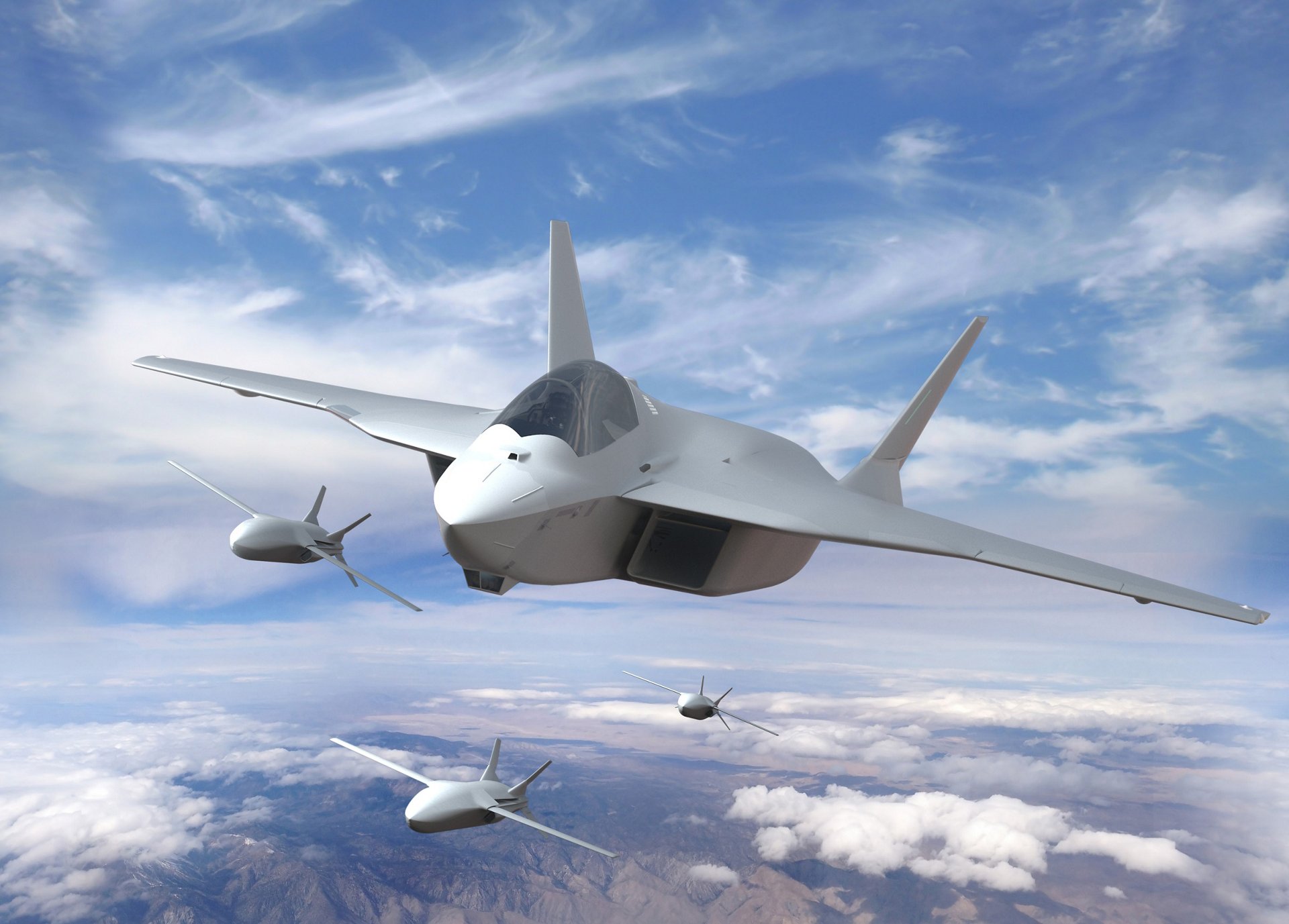
Credit: Airbus
Conversely, there is some speculation that the sixth-generation fighters might be the last manned tactical aircraft ever built. Proponents of this theory point to recent and expected advancements in AI-guided aircraft which, in their view, could make manned fighters superfluous. In addition to the life-saving aspect of taking humans out of the cockpit, they point to the lower cost of UAVs; both aspects would make the aircraft more ‘attritable’ and thus suitable for riskier mission profiles against extremely high-value targets. Whether armed forces would ever want to completely lose the human pilot’s control over critical decision making is questionable, but a proportional shift in favour of AI-guided aircraft is a strong possibility.
Long-range bombers
The US Air Force is the only Western service which operates long-range or strategic bombers. The USAF is currently introducing the B-21 Raider, whose numerical designator is a clear reflection of the plane’s status as the 21st century bomber, ultimately replacing the legacy B-1B and B-2A. Manufacturer Northrop Grumman describes the B-21 as “the world’s first sixth-generation aircraft [representing] a new era of capability and flexibility through advanced integration of data, sensors and weapons.” The firm emphasises that the aircraft’s open architecture design enables rapid upgrading throughout its service life in order to outpace evolving threats. The USAF states that the “highly survivable” stealth-equipped B-21 “will possess the range, access, and payload to penetrate the most highly-contested threat environments.” Very few details of the design have been made public to date with even the number of internally-placed engines – two or four – remaining classified.
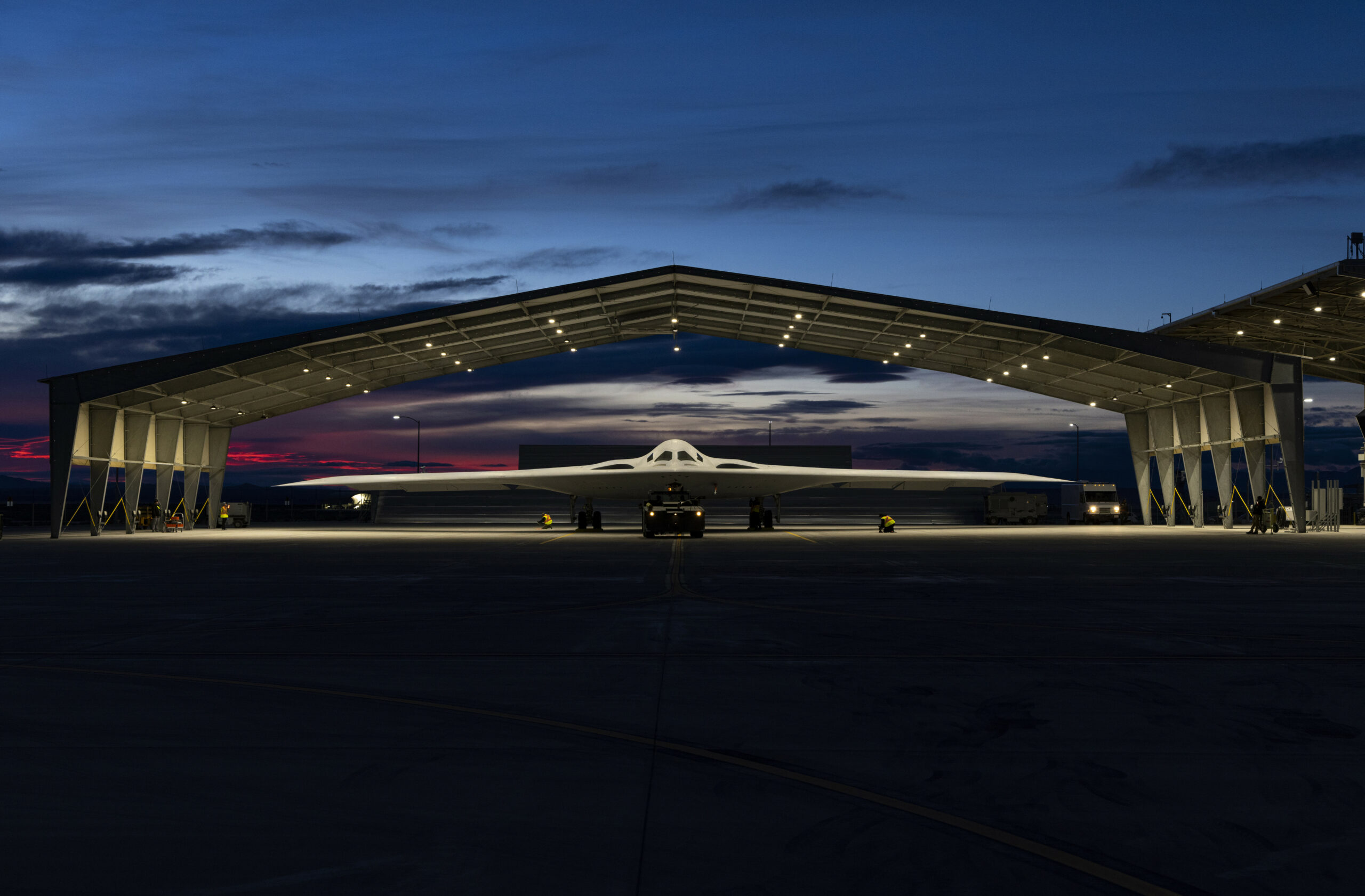
Credit: USAF
Northrop Grumman was awarded the Low-Rate Initial Production (LRIP) in late 2023, following first flight of a test aircraft on 10 November 2023. The number of aircraft in the first tranche was not revealed. According to William LaPlante, Undersecretary of Defense for acquisition and sustainment, the B-21 is “expected to enter service in the mid-2020s, with a production goal of a minimum of 100 aircraft.” The new bombers are currently undergoing an intensive flight-testing campaign at Edwards Air Force Base, California. While the USAF has been careful to minimise visual access to the aircraft – presumably to prevent adversaries gleaning insight from its visual configuration – the service did publish the first photos from flight testing on 22 May 2024, however, the images were taken at angles, presumably to minimise details. As one point of interest, observers noted a lack of blackening around the exhaust outlets, which could imply that exhaust is being cooled internally before venting; or, alternately it could simply reflect the fact that very few flight hours have been conducted so far.
Considerable uncertainty surrounds the procurement programme. Unit costs, which have been estimated at approximately USD 500 million per aircraft, are not in the public domain. Exact production rates and schedules have also not been revealed, except in general terms. During his 12 March 2024 testimony before the House Armed Services Committee (HASC), Lt. Gen. Richard Moore Jr, Air Force Deputy Chief of Staff for Plans and Programs, stated that the current goal of 100 aircraft “takes us for procurement into the late 2030s.” Moore told the HASC that a decision point regarding procurement beyond 100 units would be somewhere in the mid- to late-2030s, and that an earlier decision would be premature. “The decision whether or not to go past that may very well not be based on China, because it will be made at a time when we don’t foresee the security environment and we don’t need to,” Moore said.

Credit: USAF
Air Force Chief of Staff Gen. David W. Allvin reinforced this sentiment during testimony before the Senate Armed Services Committee (SASC) on 16 April 2024. While referring to the B-21 as “the future of our bomber force,” Allvin explained that the service would avoid committing prematurely to more than 100 bombers before evaluating what new technological advancements will be available by the 2030s. Depending on developments by the middle of the coming decade, the USAF may choose to pursue an alternate bomber design that will prove even more effective. In that case, a mixed fleet of B-21s and the as yet unforeseen platform would serve through the remainder of the century.
Air mobility – transport and tankers
Fighters and bombers receive the most popular attention, but refuelling and transport aircraft remain a decisive element of any war plan. Significant modernisation is planned here too, in order to maintain a well-balanced and mutually-supportive force structure. This is especially true for the USAF, which maintains the largest air mobility force, but should hold in general for any air force involved in expeditionary warfare. General Michael Minihan, commander of USAF’s Air Mobility Command (AMC), emphasises the need for future operational integration of fighters, bombers, tankers, transports and weapons. “Integration [is] needed at the higher level [and] needs to be addressed aggressively,” he said during a 28 March 2024 webinar. Moving forward, combat and mobility aircraft must be developed “as a system,” Minihan stressed.
While stealth is primarily viewed as an attribute of combat aircraft, future tankers and airlifters are likely to display a variety of signature-reduction characteristics to enhance their ability to operate in contested airspace. Only a portion of the airlift and tanker fleet is expected to need the highest level (and costliest) signature reduction. “We’ve got to have a fleet that can go into the high weapons engagement zone that has an enormous amount of risk,” Minihan said. However, many airlift missions will still take place in safe or “permissive” environments, while others will be conducted in mid-threat-level “semi-permissive” areas, he said. An optimised air mobility fleet will operate several aircraft types with different levels of low-observability attributes, whereby Minihan expressed doubt that they would reflect the same degree of stealth as fighters and bombers.
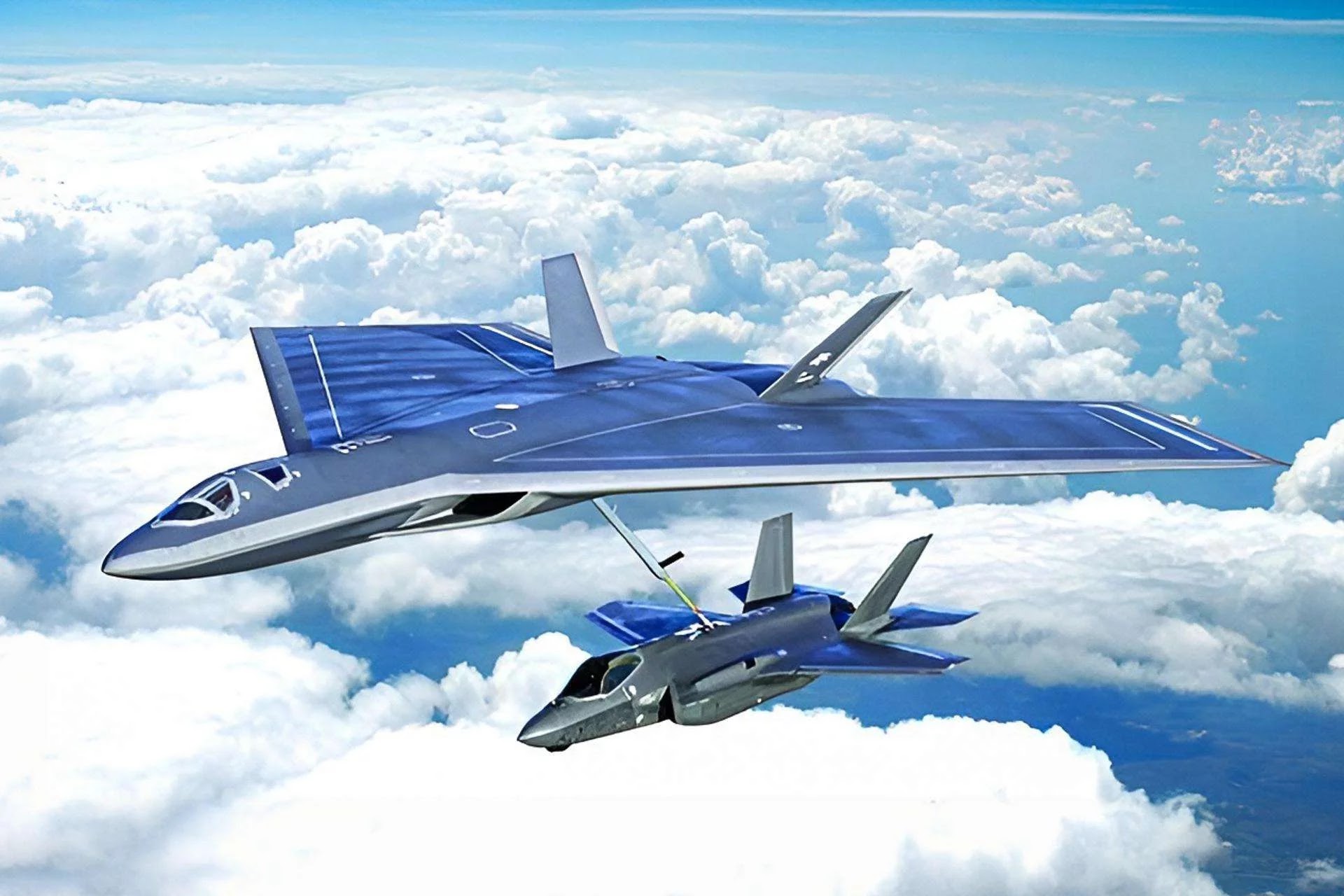
Credit: Lockheed Martin
Tankers would arguably also have a great need for low-observability characteristics. This would permit them to accompany or trail combat aircraft on deep penetration missions into enemy or contested airspace. In February 2023, the USAF presented a Request for Information (RFI) for a “Next Generation Aerial-refuelling System” (NGAS), citing a need to field a more survivable tanker by 2040. While the service avoided the terms ‘stealth’ or ‘low-observability’ in the RFI, it made clear that the goal was an aircraft capable of operating during a peer- or near-peer conflict. It must “be able to survive and operate in a much more contested environment than the tankers of the past or the tankers that are in our current fleet,” said Air Force Assistant Secretary for Acquisition, Technology and Logistics, Andrew Hunter, during a press briefing in March 2023. The USAF wants tankers that can “go deeper into contested airspace, have more advanced self-protection capabilities and more advanced networking capabilities,” Hunter said. The profile of desired capabilities (which will likely include enhanced range and payload) will emerge from the Analysis of Alternatives to be completed in October 2024.
Kevin Stamey, Director for Mobility and Training Aircraft at Air Force Material Command, briefed reporters on the NGAS programme during the Aerial Refueling Systems Advisory Group’s (ARSAG) annual conference on 24 April 2024. According to Stamey, AMC is currently leaning toward a stealth-design jet aircraft approximately the size of the C-130 Hercules. The NGAS would receive fuel from a large-capacity, commercially-based tanker (KC-135, KC-46A) in uncontested airspace, accompany the fighters or bombers into the contested airspace, and refuel them as they approach their targets. The NGAS would then return to safe airspace, rendezvous with the larger tanker to replenish supplies, then head back to meet and refuel the returning combat aircraft. Whether a tanker could retain its stealth (and that of the receiving aircraft) once it extends its boom was debated at the ARSAG conference; on that question, Stamey reported seeing classified industry submissions which seem to promise viable low-observability throughout the mission. Both Boeing and Lockheed Martin are developing NGAS concepts. Lockheed Martin has released artwork featuring radar-signature minimising architecture including lambda style wings and recessed air inlets for the engines.
Parallel to NGAS, the USAF is pursuing the Next Generation Airlift (NGAL) platform. NGAL is conceived as a family of aircraft, to be procured in several sizes and performance profiles. They will ultimately replace the C-17 and C-130 airlifters and introduce new capabilities by adding smaller, more flexible aircraft into the force mix. According to AMC, next-generation and “generation-after-next” transport aircraft are expected to present “revolutionary” rather than evolutionary designs and capabilities in order to deploy and survive in high-threat environments. Optionally-unmanned operations and vertical take-off and landing capabilities are among the technologies being considered.
As part of the NGAL initiative, the USAF is interested in a blended wing body (BWB) design. Depending on the overall configuration – such as the position of the engines – BWBs can have a naturally reduced radar cross section (RCS), although it is not necessarily a stealthy design per se. Since BWBs generate lift with the fuselage as well as the wings, they can achieve much greater fuel efficiency as well as improved range and airspeed when compared to conventional tube-and-wing designs. In August 2023, the USAF awarded California-based JetZero a contract to build a large BWB demonstrator suitable for the cargo or tanker role; flight testing could begin in 2027. The firm believes the plane could be production ready by 2030, a goal which could be excessively optimistic for an as yet unproven design. JetZero is not alone in pursuing blended wing body concepts. In January 2023, Boeing presented the model of a BWB tactical transport with numerous low-observability features; the firm cautioned that the concept is still in early stages of development, and postulated that it could be operational by the mid- to late-2030s. Airbus has also presented a concept for a BWB transport aircraft with a 3,704 km (2,000 NM) range; while not specifically targeted for military applications, this design, too, could be adapted for air mobility operations.
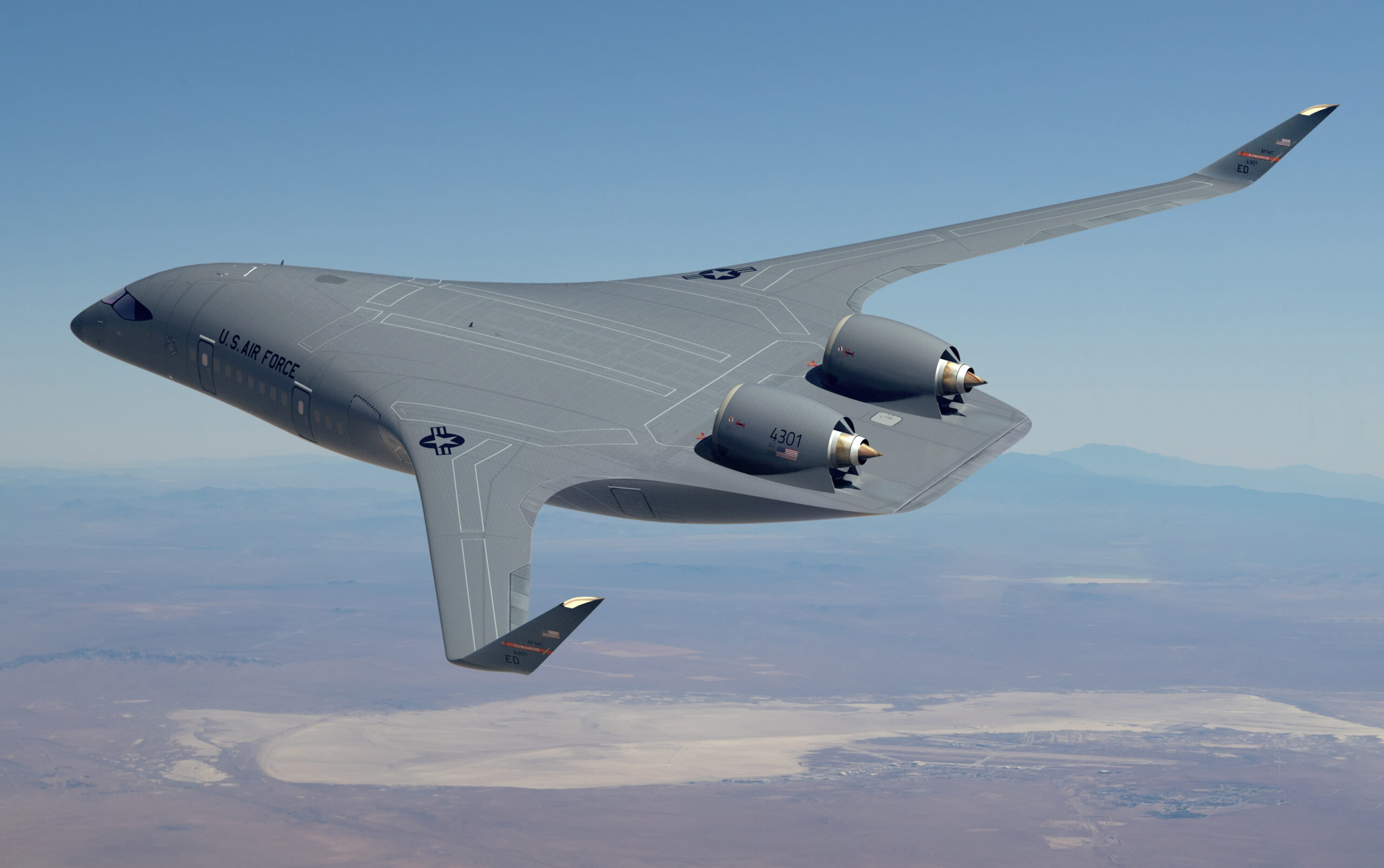
Credit: JetZero
In addition to introducing new models and classes, armed forces are likely to add supplementary missions for air mobility aircraft. USAF has recently demonstrated the ability of C-130 and C-17 platforms to deploy cruise missiles (palletised munitions) via the ‘Rapid Dragon’ programme. This operational concept permits transports to quickly augment dedicated combat aircraft, applying overwhelming mass or attacking from multiple quadrants to overwhelm enemy defences, then return to their primary airlift mission. Another likely additional function will be service as communications relays and datalinks to enhance command and control, situational awareness, and targeting. Tankers and airlifters retain a comparatively large onboard space availability – what Minihan refers to as “a lot of real estate” – which could accommodate new hardware and personnel without compromising the ability to perform the primary mission.
Specialty, support and enabler aircraft
To date, all planned replacement programmes for EW aircraft, Surveillance and Targeting aircraft and Airborne Early Warning and Command (AEW&C) aircraft are based on modified commercial aircraft designs. This raises the question of how to provide the respective support services to combat and air mobility units as these venture deeper into contested airspace. The current practice of keeping the support aircraft at a safe distance outside the conflicted zone will become increasingly impractical as enemies field very long-range (and potentially hypersonic) air defence weapons. Clean-sheet stealth designs for a relatively small number of specialised platforms is not economical. Two mutually supportive solutions appear readily available.
The current discussion of sixth-generation air dominance ‘systems of systems’ already proposes assigning EW, land and air reconnaissance, and command and communications node functions to a portion of the unmanned escort aircraft. The manned next generation fighters are also expected to have significantly enhanced EW capability compared to current aircraft. These tactical units could be augmented by stealth-configured air mobility platforms equipped – either permanently or rotationally – for the respective support missions. In aggregate, the EW, surveillance and targeting, and command and control (C2) missions will become platform agnostic, transitioning to hardware and software-based capabilities which can be deployed on demand by a wide array of aircraft operating in conjunction with space-based assets.
Common issues
While there has been much focus on the attributes of next-generation combat systems, there are numerous technological developments that will be applied to all categories of aircraft in one way or another, though this does not imply a ‘one-size-fits-all’ approach. Fighters, bombers, air mobility and support aircraft all have their own operational concepts and requirements, and varying levels of exposure to enemy threats. Yet all will be required to keep pace with newest capabilities in order to remain relevant.
Networking and advanced comms
Today’s level of communication links and networking, enabling data sharing and coordinated operations between diverse aircraft, vessels and ground forces far exceeds what was available to pilots one generation ago. Next-generation pilots and aircraft will be far more networked than those of the present. Satellites, UAVs and high-performance on-board data links and communications systems will provide an unprecedented real-time situational awareness and enable sensor-shooter networks to maximise offensive capabilities. By turning every aircraft, including air mobility airframes, into a communications hub, current gaps in coverage – especially when operating in large theatres – will be eliminated.
‘AI Co-Pilot’, optional manning, MUM-T
Next-generation manned fighter aircraft will be paired with CCA to enhance offensive and defensive capabilities. Additionally, the USAF also plans to provide two CCA escorts to each fifth-generation F-35 fighter. There has been discussion of enabling bombers and transport aircraft to also control unmanned escorts to defend them from surface-to-air missiles (SAMs) or enemy aircraft, whether manned or unmanned. In 2022, US Air Force Secretary Frank Kendall discussed plans to provide the B-21 bomber unmanned escorts as penetration aids. At the time, Kendall referred to extremely high-performance aircraft which would be approximately the size of manned fighters, have a 2,778 km (1,500 NM) range and a 2,200 kg internal payload, and cost more than USD 300 million each. That idea has been retired for the moment. On the other hand, Kevin Stamey revealed that escorts are under consideration to protect stealth tankers. That particular project aside, it seems likely that the US and other nations’ armed forces will at some point reconsider lower cost CCA to enhance survivability of larger manned aircraft operating in or near contested regions.

Credit: BAE Systems
Over and above the MUM-T concept, AI is becoming ubiquitous for all military aircraft concepts. So-called AI-copilots are expected to assume an increasing share of the cockpit workload. On the one hand, this includes routine functions, which will enable the human crew to concentrate on the most critical aspects of an operation, especially those involving tactical decision-making. However, AI is expected to support the crew here, too; as on-board sensors and tactical data streams from off-board platforms threaten to cognitively overwhelm pilots, AI will sort through the incoming information, triaging and prioritising what is presented to the crew. Finally, while most major aircraft categories appear set to remain manned for the foreseeable future, many developmental projects require industry to integrate optional manning into the base designs, giving operators flexibility in case of pilot shortages or in the face of unacceptable risks on a given mission.
Self-protection suite
Non-combat next-generation aircraft will require enhanced self-protection capabilities. These will include defensive EW and cybersecurity suites to prevent interference with navigation or on-board electronic systems. Jamming systems or laser dazzlers to disable targeting sensors on enemy missiles or UAVs have also been proposed. According to Kevin Stamey, unspecified kinetic self-defence solutions are also being considered for stealth tankers. The Air Force Research Library has been pursuing small interceptor missiles as close-range defence against anti-aircraft missiles. While primarily conceived for carriage on fighter aircraft, they could likely be adapted for large airframes as well if the appropriate fire-control systems can be integrated on the planes.
Improved propulsion and extended range
Future aircraft will require improved propulsion systems in order to achieve better range, higher payload capacity, and presumably improved airspeed (at least for ‘dash’ phases). Engines will need to combine enhanced thrust with greater efficiency, while also providing more electricity generation to power a multitude of new sensors and other electronic systems and payloads. One drawback of more powerful engines is the greater heat production, which increases stress on the aircraft and magnifies the thermal signature. Future engine designs will need to incorporate enhanced cooling systems and utilise new heat resistant materials. Both in Europe and the United States, research and development for new engines optimised for sixth-generation combat aircraft is underway, with prototyping expected within a few years.
In order to preserve stealth or minimise radar profiles, aircraft will need to carry all fuel internally for major portions of the mission. While aerial refuelling is likely to be a universal capability (and the introduction of unmanned tanker aircraft will improve refuelling availability), lower fuel consumption will be a key factor in extending operational reach. The replacement of some metal components with lighter-weight composite materials will also contribute to extended range.
Technology challenges and budget constraints will be decisive
While defence ministries and industry alike place great expectations regarding future aircraft designs, there are two major variables to consider: a) unrealistic or premature demands; and b) budgetary constraints. The past few decades were filled with promising aircraft concepts which were cancelled because key technologies were immature, or the design did not perform as promised. Other projects, such as the fifth-generation F-35, have been plagued by delays caused by anything from technological immaturity to supply chain shortages. The propensity of armed forces to request design changes once construction has begun is another factor which can lead to significant delays in fielding or certifying operational systems. Given the revolutionary nature of the design and performance parameters expected of next-generation aircraft – whether combat or air mobility – it would be advisable to take the proposed timelines for production and fielding these systems with a grain of salt.
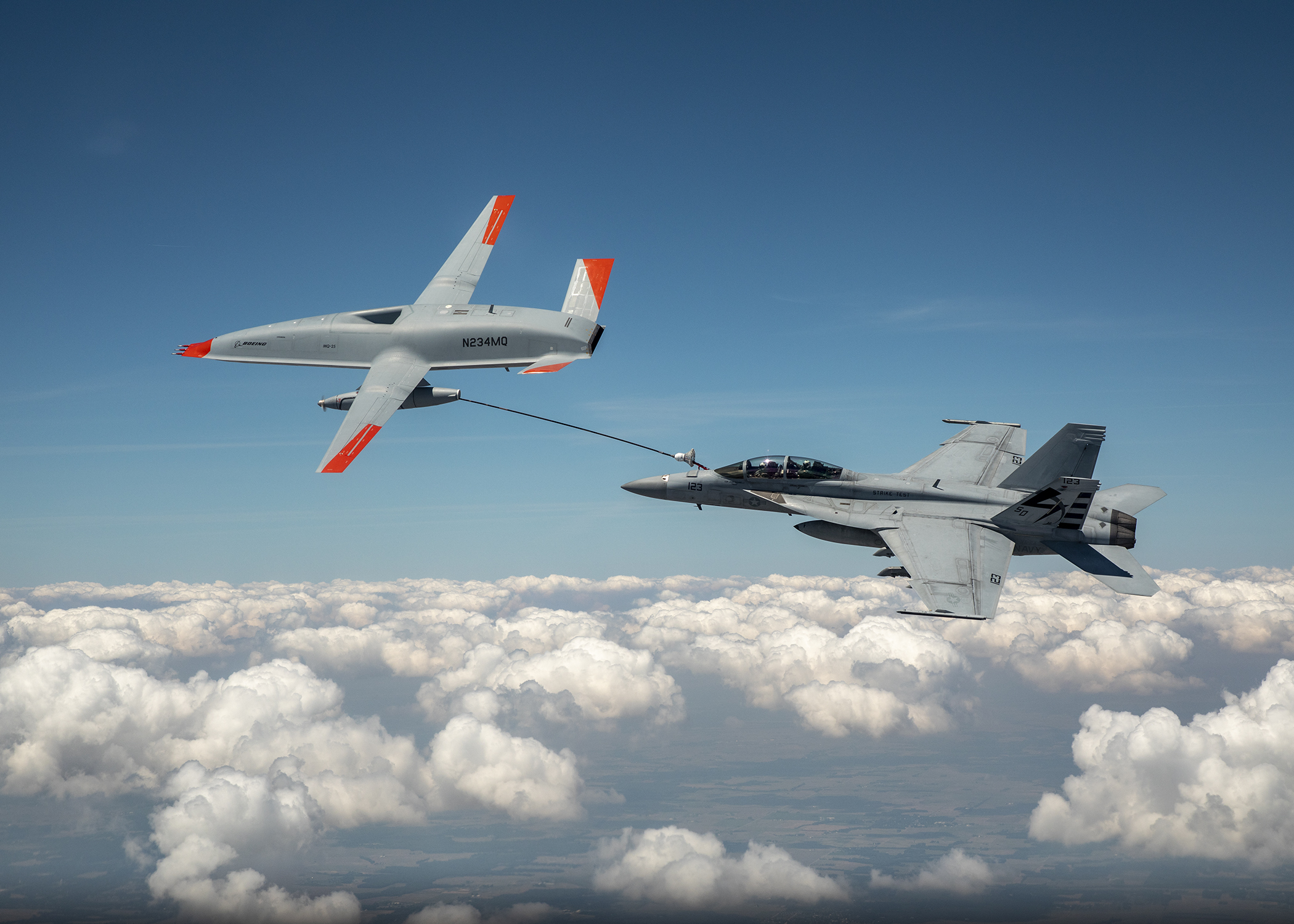
Credit: US Navy
As for budgetary considerations, the manned aircraft being proposed are forecast to be considerably more expensive than legacy systems. This is particularly the case with combat aircraft – extreme performance enhancements will not be cheap. The US Air Force’s manned NGAD fighter is expected to cost approximately USD 300 million per unit, roughly triple the price of the F-35. In the past, procurement of high-performance platforms– such as the F-22 Raptor – has been truncated well below levels advocated by the armed forces. Soaring procurement costs were the primary motivator for such cancellations. Budgets are under even greater pressure today, given the general rise in defence procurement costs, and the soaring budget deficits in many nations. While it is unlikely that the legislative bodies of the various nations will completely cancel sixth-generation aircraft programmes, there remains a real risk that they will set procurement limits below those deemed necessary by the armed forces. The increasing capability of unmanned aircraft, including those being directly conceived as part of the sixth-generation systems of systems, will provide budget conscious legislators additional justifications for advocating bare-minimum acquisition of the most sophisticated manned aircraft. Ultimately this is likely to go beyond combat aircraft, given ongoing research and development of unmanned transport and tanker aircraft.
Sidney E. Dean



![Countering the aerial threat Based at NAS Key West in Florida, US Naval reserve squadron VFC-111 operates the F-5N Tiger II in the aggressor role. [USMC/SSgt Dengrier Baez]](https://euro-sd.com/wp-content/uploads/2025/06/A1-Kopie-218x150.jpg)
![US air dominance: The story so far President Trump, the 47th President, said that the USAF’s first sixth generation fighter would be known as the F-47, insisting that: “The generals picked a title, and it's a beautiful number…” Trump also noted that “an experimental version of the plane has secretly been flying for almost five years.” [USAF]](https://euro-sd.com/wp-content/uploads/2025/06/2-F-47-8928628-1-Kopie-218x150.jpg)

